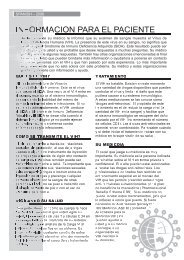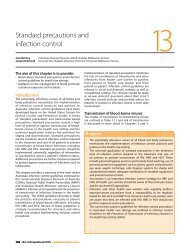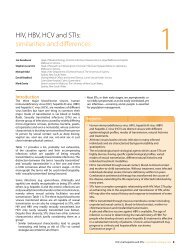B Positive – all you wanted to know about - ASHM
B Positive – all you wanted to know about - ASHM
B Positive – all you wanted to know about - ASHM
You also want an ePaper? Increase the reach of your titles
YUMPU automatically turns print PDFs into web optimized ePapers that Google loves.
INFECTION CONTROL AND<br />
OCCUPATIONAL HEALTH<br />
Jacqui Richmond St Vincent’s Hospital, Melbourne, VIC.<br />
Links <strong>to</strong>: Chapter 4: Natural his<strong>to</strong>ry of chronic hepatitis B virus infection<br />
Chapter 5: Primary prevention of hepatitis B virus infection<br />
Chapter 1 : Privacy, confidentiality and other legal responsibilities<br />
KEY POINTS<br />
Myths and facts<br />
MytH <strong>–</strong> Wearing gloves means <strong>you</strong> do not need <strong>to</strong> wash <strong>you</strong>r hands.<br />
fact <strong>–</strong> Gloves are not a substitute for effective hand-washing.<br />
MytH <strong>–</strong> Health care workers should use additional precautions when caring for a patient with HbV <strong>to</strong> prevent<br />
transmission.<br />
fact <strong>–</strong> the implementation of standard precautions ensures a high level of protection against the transmission of HbV<br />
in the health care setting.<br />
MytH <strong>–</strong> Health care workers need <strong>to</strong> have booster doses of hepatitis b vaccine every five years.<br />
fact <strong>–</strong> booster doses are no longer recommended in immunocompetent individuals after a primary course of HbV<br />
vaccine, as evidence suggests that a completed course of HbV vaccination provides long-lasting protection.<br />
MytH <strong>–</strong> Health care workers with HbV must not have contact with patients because of the risk of transmission.<br />
fact <strong>–</strong> Health care workers with HbV are gener<strong>all</strong>y advised <strong>to</strong> avoid performing exposure prone procedures, however,<br />
they can still have non-invasive contact with patients.<br />
8 b <strong>Positive</strong> <strong>–</strong> <strong>all</strong> <strong>you</strong> <strong>wanted</strong> <strong>to</strong> <strong>know</strong> <strong>about</strong> hepatitis b: a guide for primary care providers<br />
11<br />
� the potenti<strong>all</strong>y infectious nature of <strong>all</strong> blood and body substances necessitates the implementation<br />
of infection control practices and policies in the health care setting.<br />
� the current best practice guidelines for infection control procedures in australian<br />
health care settings are outlined in Infection Control Guidelines for the Prevention<br />
of Transmission of Infectious Diseases in the Health Care Setting (2004), accessible at<br />
http://www.health.gov.au/internet/wcms/Publishing.nsf/content/icg-guidelines-index.htm<br />
� the universal application of standard precautions is the minimum level of infection control<br />
required in the treatment and care of <strong>all</strong> patients <strong>to</strong> prevent the transmission of hepatitis b virus<br />
(HbV). these include personal hygiene practices—particularly hand-washing, the use of personal<br />
protective equipment such as gloves, gowns and protective eye wear, aseptic techniques, safe<br />
disposal systems for sharps and contaminated matter, the adequate sterilisation of reusable<br />
equipment and environmental controls.<br />
� Vaccination is an important infection control strategy for the prevention of HbV. <strong>all</strong> health care<br />
workers should be vaccinated and be aware of their vaccination status.<br />
� clinicians and other health care workers who regularly perform exposure-prone procedures have<br />
a responsibility <strong>to</strong> be regularly tested for the human immunodeficiency virus (HiV), the hepatitis c<br />
virus (HcV) and HbV if they are not immune. Health care workers who are infected with HiV, HbV or<br />
HcV should not perform exposure prone procedures.






